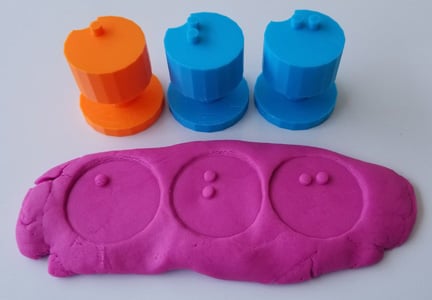What do you remember most fondly about your childhood? It is probably the texture of your favorite Barbie’s hair, the hissing sound of the wheels of your toy truck (that you played with every day until your parents’ made you share it with your younger sister), or the satisfying coldness of a snowball fight with your neighborhood friends.
Child psychologists and educators see play as a “necessity”[1] for developing brain function, memory, and humor, all of which can help children cope well later in life with a variety of obstacles and difficulties. Play is a way for children (and adults too!) to conceptualize seemingly impossible realities and help cement these critical developmental tools.
Whether you are a parent or an educator of a blind or low-vision child, there’s a variety of tactile and sensory toys available to assist you in creating deeper connections and having more meaningful moments of play.
Here are a few to add to your holiday shopping list!
Encourage vocalization with a megaphone that offers a variety of different noises. Using megaphones frequently can help children recognize tone inflection which accounts for 38% of speech communication[2]. The one featured above offers a variety of noises, including “Robot, Spooky, Monster, Ghost, & Alien,” for opportunities for fun and playfulness.
If giving your child unlimited access to a megaphone sounds overwhelming to you, making time once a week for karaoke is another way to emphasize the meaning behind different noises and communicate storytelling. This is also a great way to help children relieve stress and can even establish a long-term outlet for emotional regulation.[3] The karaoke machine above also includes two microphones which makes it easy to play together or apart.

Wonderbaby recommends Battat Sound Puzzle Box for its lightly challenging exercise of fitting the shapes into their corresponding holes and the sing-song noise it makes when you are successful. This is a great tool for babies and toddlers who enjoy more interactive problem-solving games and helps enhance their confidence with coordination.

These sticks are a way to engage with spatial awareness and creatively. These non-toxic waxed sticks are popular because you can create a variety of 3-D shapes without mess. These has been awarded Parent’s Choice and Best Creative Child Award, and are a favorite among children of all ages. These are also affordable, ranging from $7-$15 for a set. Their website explains the ways they can help children engage different parts of the brain:
- “Wikki Stix are ideal for tactile For example they can be used to demonstrate math concepts (more/less), and prepositional awareness (over, under). They are ideal for making borders, showing where to start and stop on the paper, and as a border to color within the lines” Do-Wikki Game | Wikki Stix
Older kids will enjoy playing games such as Poker, Go Fish, War, Spi. Previously, playing with accessible cards has been the main barrier for blind or low-vision individuals. But now that vendors like Etsy are making braille card games at affordable rates (the one above is only $13) the blind and visually impaired of all ages can benefit. This is a great way to bond with friends and family and is a known way to help improve memory, increase brain volume, and generally liven up a rainy afternoon!

A great multi-sensory way to learn braille, increase literacy skills, and add accessibility to playtime! Each of the 26 stamps has the raised braille letter on top for identification, with an indent at the top left to orient the letter. The bottom of the stamp has the inverted braille cell, so when you stamp Play-Doh, clay, or some slimes, the raised braille letter appears! You can make braille words; practice finding the stamper that matches the letter on the dough; label your creations; and more.
Tactile toys are also an important part of our ReadBooks! Bags Program because tactile play is an important part of building pre-braille skills. These free bags contain a tactile toy like Wikki Stixx plus a print/braille book and other braille literacy resources for children and families just getting started with braille.
References:
Lindblom, Bjorn, and Rolf Zetterstrom. “Precursors of Early Speech.” Precursors of Early Speech, EPub ed., vol. 44, London, United Kingdom, Palgrave Macmillan, 1986, pp. 269–77.
Ginsburg, Kenneth. “The Importance of Play in Promoting Healthy Child Development and Maintaining Strong Parent-Child Bonds.” American Academy of Pediatrics, 1 Jan. 2007, pediatrics.aappublications.org/content/119/1/182.
Uhlig, Sylka, et al. “Rap and Singing Are Used by Music Therapists to Enhance Emotional Self-Regulation of Youth: Results of a Survey of Music Therapists in the Netherlands.” The Arts in Psychotherapy, vol. 53, 2017, pp. 44–54. Crossref, doi:10.1016/j.aip.2016.12.001.
[1] The Importance of Play in Promoting Healthy Child Development and Maintaining Strong Parent-Child Bonds
[2] Precursors of Early Speech
[3] Rap and Singing are used by Music Therapists to Enhance Emotional Self-Regulation of Youth
